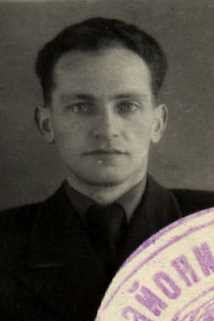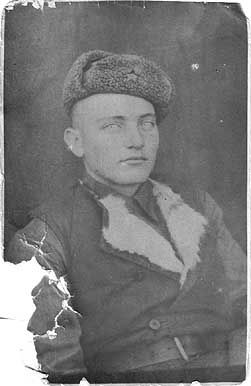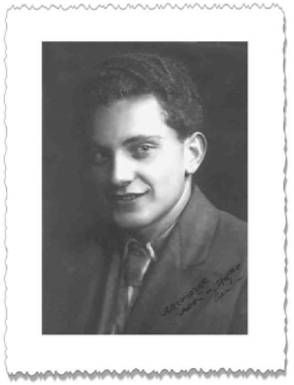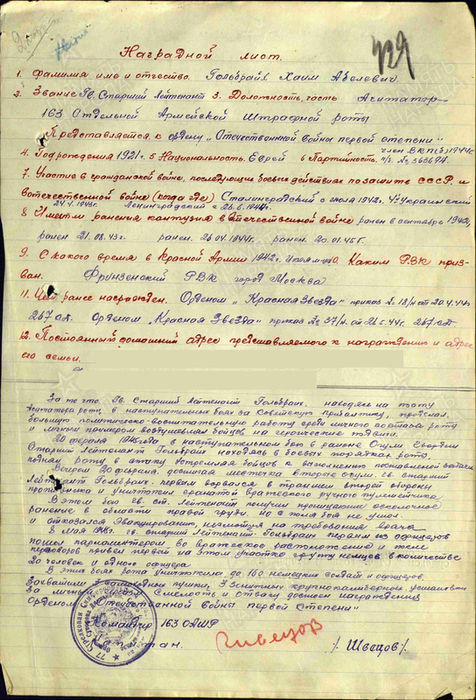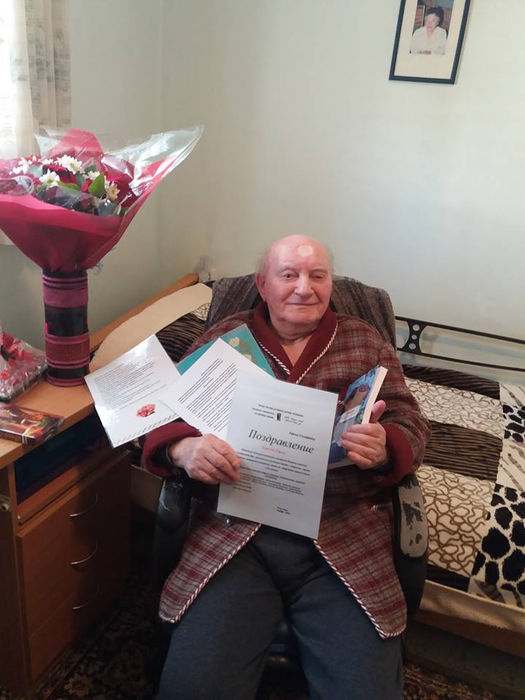May 7, 2021 marked the 77th anniversary of the legendary feat of Soviet soldiers – the storming of Sapun Mountain. On this day, the troops of the 51st and Primorsky armies of the 4th Ukrainian Front, overcoming the fierce resistance of the enemy, took by storm the most serious fortification of the Germans, blocking the path to Sevastopol. Thanks to the heroism of Soviet soldiers and officers, on May 9, 1944, the hero-city was liberated. The remnants of the German 17th Army were overtaken at Cape Chersonesos and finally defeated.
The storming of Sapun Mountain on May 7, 1944 became the subject of the world's largest diorama, located in the State Museum of the Heroic Defense and Liberation of Sevastopol.
One of the heroes who distinguished themselves in the battle for Sevastopol was EFIM GOLBRAIKH (1921-2020), who served in May 1944 as a Komsomol organizer of the 1st Battalion of the 844th Infantry Regiment of the 267th Infantry Sivash Division. According to archival documents, on May 21, 1944, for a battle in the Sapun-Gora region, the guard Lieutenant Efim (according to documents – Chaim) Golbraikh was awarded the Order of the Red Star.
As recorded in the order of awarding, Guard Lieutenant Golbraikh on May 7, 1944, under fierce enemy fire, raised the fighters to attack. Being in the battle formations of the advancing infantry, Golbraikh burst into the enemy trenches, destroying the German submachine gunner with a grenade. Despite heavy fire from the flank and rear – the not yet occupied village of Sakharnaya Golovka – the lieutenant led a group of fighters to storm Sapun Mountain. At the end of the battle, Golbraikh’s group broke into the summit and set up a red banner there.
Many years later, Efim Abelevich told the details of this operation. Firstly, there was actually more than one banner – another red flag was flying a kilometer from the place where his soldiers had set the kumach. It was the “alternative” plot of the assault – by another group – that ended up in the diorama as a result. According to Golbraikh, official historians did not particularly advertise the fact that the first attempt to storm Sapun Mountain, undertaken in honor of the May 1 holiday, failed.
Efim Golbraikh had something to tell about the war - the terrible trench truth about cowardice, desertion, looting and hunger.
The front-line soldier lived a difficult, but very eventful life. He was born on December 26, 1921 in Vitebsk in a simple Jewish family. Father, Abel Golbraikh, in his youth was carried away by revolutionary ideas. In 1937 he was seized by the authorities and shot: the modest accountant of Belpischetorg was accused of “participation in a counter-revolutionary Bund organization”.
Efim had to go to school and work hard to help his mother. Before the war, Golbraikh graduated from a ten-year school and worked as an instructor at a children's technical station.
In the army, they did not want to see him, as a son of the repressed and only enrolled in the reserve of the second category. A roundabout maneuver – an attempt to enter a higher naval school – also failed. He continued to work and entered the Physics and Mathematics Faculty of the Vitebsk Pedagogical Institute.
With the beginning of the Great Patriotic War, Efim got into a student fighter battalion, which was supposed to patrol the streets of Vitebsk. The old Belgian rifles were soon taken away from the students, and the local leadership disappeared somewhere. Along with him disappeared employees of the military registration and enlistment office and the headquarters of the 27th Omsk Red Banner Division, which was stationed in the city. On July 9, 1941, having miraculously sent his mother, brother and sister to evacuation the day before, Efim Golbraikh set off on foot to the east. He left home at three o'clock in the afternoon, and at five o'clock in the western part of the city there were already German tanks and infantry.
He managed to cross the front line in the Yartsevo area, several tens of kilometers beyond Smolensk. Then he got on foot to Moscow, where distant relatives lived. In the capital, Golbraikh again tried to sign up as a volunteer for the front.
The terrible autumn and winter of 1941-1942 went by. Efim was a sophomore at the Moscow Pedagogical Institute and lived on Usachev Street in Khamovniki. Many thought that Moscow would soon fall, and a swastika would be installed on the Kremlin instead of the stars. As a result, the Germans were thrown back to the west, but the city was deserted, people were sorely lacking. Especially competent and educated commanders.
On May 5, 1942, Golbraikh was finally summoned. Thanks to the Frunze RVK of the city of Moscow, he ended up in Kazan in the 24th training reserve tank regiment, where he was trained as a gunner-radio operator of the Lend-Lease tank “Valentine”. The regimental command, noticing the intelligent young man, even planned to nominate him for the role of the Komsomol organizer, but upon learning about the repressed father, out of harm's way sent him to a reserve rifle regiment stationed in the village of Suslonger in the Mari Autonomous Soviet Socialist Republic.
After Suslanger, Golbraikh immediately fell into the very heart of the underworld – near Stalingrad, in the 594th Infantry Regiment of the 207th Infantry Division, which was defending northwest of the city. When in January 1944 Efim was awarded the medal “For the Defense of Stalingrad”. Few people know that the 207th Infantry Division of the second formation existed only during this period. Efim Golbraikh served in it from the first day until its dissolution due to total losses. He was one of the lucky few who survived. By November, only one name remained of the division. On the third day of the most terrible battles, Golbraikh was already in command of the squad, in which four fighters remained together with the commander. And a couple of weeks later he became a sergeant.
As a person with an incomplete higher education, Efim was appointed the Komsomol leader of the company. At the front his past did not particularly bother anyone, and on October 10, 1942, during a battle near the 564th kilometer junction, he was promoted. When Efim was restoring the breakthrough in communications, somehow hiding behind a wrecked tank and the corpses of the signalmen killed by a German sniper, battalion commissar Dynin died before his eyes. Golbraikh was appointed in his place – another one was added to the long list of impending dangers. Once captured, both the Jew and the Commissioner would have been immediately executed by the Germans. All the more so if it is one person.
After the disbandment of the 207th Infantry Division, Golbraikh became the company commander of the 3rd company of the 999th Infantry Regiment of the 258th Infantry Division. Under the veteran's belt are bloody battles on the Mius Front (a fortified defensive line of the Wehrmacht on the western bank of the Mius River), concussion and treatment of typhus caught in the hospital, returning to the front – to the 844th Infantry Regiment of the 267th Infantry Division of the 4th Ukrainian front.
It was possible to rest only in between injuries. After the hospital, Golbraikh served in the communications battalion for a couple of months. There, in the second echelon, it was quieter, but death was waiting just as impatiently. It was then that Golbraikh, loaded with heavy coils of wire, had to run away from a German dive bomber, who decided to practice shooting at a live target.
After the battles on the Sivash bridgehead and the capture of Sevastopol, Efim, by that time already a senior lieutenant, transferred to the 163rd separate army penal company of the 63rd rifle corps of the 77th rifle division. He asked to be sent to the penal company himself.
The division in which Golbraikh served was called “Azerbaijani” because of the large number of residents of Azerbaijan and, in general, people from the Caucasus, who were called up to it in the fall of 1942 on the territory of the Dagestan Autonomous Soviet Socialist Republic. The harshness reigned there. For committing a grave crime, the commander had the right to shoot. Once the penalties themselves caught a deserter from their own company and shot him. Out of solidarity with them, the commanders kept silent. It is vitally important to know and understand who you are going into battle with. With all this, the penalized soldiers were still much stricter with discipline. And Efim wrote a report with a request to appoint him deputy commander of the 163rd penal company.
The front was a good illustration of the paradoxical contradictions of the Soviet army, in which the heroism of the common soldier and the carelessness of the command, impeccably carried out operations and criminal frontal attacks went hand in hand.
Efim noted that one of the reasons for frequent failures was rampant drunkenness. A striking example of this was the operation of the capture of the Popelnya station in the Zhytomyr region by Soviet units. Having recaptured the station, the Soviet tank crews found there an “accidentally” forgotten by the Germans a tank of alcohol. A few hours later, an echelon of German tanks arrived at the station, which quite calmly unloaded and knocked the Soviet soldiers out of an important railway junction. Soviet T-34s stood without crews – the tankers thoroughly “refueled” with the found alcohol.
In July 1944, as part of the 51st Army, the penal company was transferred to the Baltic States. Efim managed to get out to his native Vitebsk for a short time. There - not a single acquaintance. The entire city was destroyed and burned, friends and relatives were killed or missing. Some, like his former institute teacher, orientalist Brandt, were killed by partisans for actively aiding the enemy. For some reason, the sudden transformation of this particular person, although there were, unfortunately, enough collaborators in the city, struck Efim especially strongly.
The hardest battles for Latvia, Lithuania and northeastern Prussia still awaited Golbraikh. Reflecting numerous counterattacks, with serious losses, the Strafkompanie took the Dobele region in Latvia, and stormed Šiauliai several times.
On February 20, 1945, in an offensive battle near the town of Oguli, Efim Golbraikh performed another feat. He was the first to break into the trenches of the enemy's second line of defense and personally shot a German who was shooting Soviet soldiers with a light machine gun. Having received a shrapnel penetrating chest wound in this battle, the senior lieutenant of the guard refused to leave the battlefield, despite the doctor's request, and remained with his fighters until the task was successfully completed.
Together with his division, Efim ended the war in Courland. Parts of the Wehrmacht surrendered to the battle formations of the 77th division on May 8, 1945. Golbraikh was the first among the officers to enter the enemy location and led a group of 20 voluntarily surrendered German soldiers and one officer.
The dry lines of the award order do not convey the moral stress experienced by the senior lieutenant of the guard. Berlin had already been taken, and the 77th division continued to fire at German pillboxes and four tanks dug into the ground. The Germans were in no hurry to surrender – they did not expect anything good from the Soviet soldiers. In the company, the only person who spoke German was Efim. To die on the last day of the war is the most offensive death possible. But the Komsomol member had to set a personal example for everyone ... And the senior lieutenant took off his belt with a holster, took an impromptu white flag and walked towards the enemy along a narrow passage cleared of mines. One of his soldiers hastened to help Golbraikh. So together they went down into the German trench, where the Nazis were waiting for another firefight and fiercely argued among themselves. Clutching a hand grenade in his pocket, Golbraikh, offered the Hitlerite colonel life in exchange for surrender. On the occasion of the end of the war, all the soldiers of the company received an amnesty.
For the battle near the town of Oguli and the acceptance of the German surrender in June 1945, Efim Golbraikh was awarded the Order of the Patriotic War of the 1st degree. There were also other awards: one more Order of the Red Star, a medal “For the Defense of Moscow” and “For Victory over Germany in the Great Patriotic War of 1941-1945”.
After the war, Efim remained in the army. First he served as the head of the club of the 64th Guards Rifle Regiment of the 21st Guards Rifle Division, then in other positions in the garrisons of the Baltic Military District. In October 1953, he retired with the rank of major and left for Tajikistan with his wife – retirees were given apartments either in the far north or in the far south of the Soviet Union.
In Dushanbe, Golbraikh served for many years as deputy director of the Mayakovsky Russian Drama Theater.
A creative man, Efim Golbraikh, after the war, slowly began to write. Literature helped to cope with the losses experienced during the war, to heal mental wounds.
Since 1991, Efim has lived with his family in Israel. In the Holy Land, collections of essays, several volumes of memoirs, newspaper and magazine articles were added to the “Notes of a Theater Administrator” and the book “Scattered Lines of the Past War” published in the Soviet Union. “I have not returned from the war”, – this is how Golbraikh described his writing credo, who for many years was a member of the Union of Russian-speaking writers in Israel. In 2011, his colleagues presented him with the Nekrasov prize, and the mayor's office of the city of Rishon LeZion awarded him the title of “Person of the Year”.
Celebrating May 9th every year, Efim Golbraikh proudly wore not only Soviet, but also Israeli awards. Not only because of his love for the country for which he never had to fight, but also in memory of the Jews who died during the Second World War. Efim was very proud of his great-grandson, who was marked as the best soldier during his service in the IDF.
The hero of the Great Patriotic War, Efim Golbraikh, passed away in the summer of 2020. Let us remember on this festive day the glorious warrior, the chronicler of the bygone terrible war, whose heart has forever remained under the regimental banner on Sapun Mountain.
Efim Golbraikh
1921 – 2020


